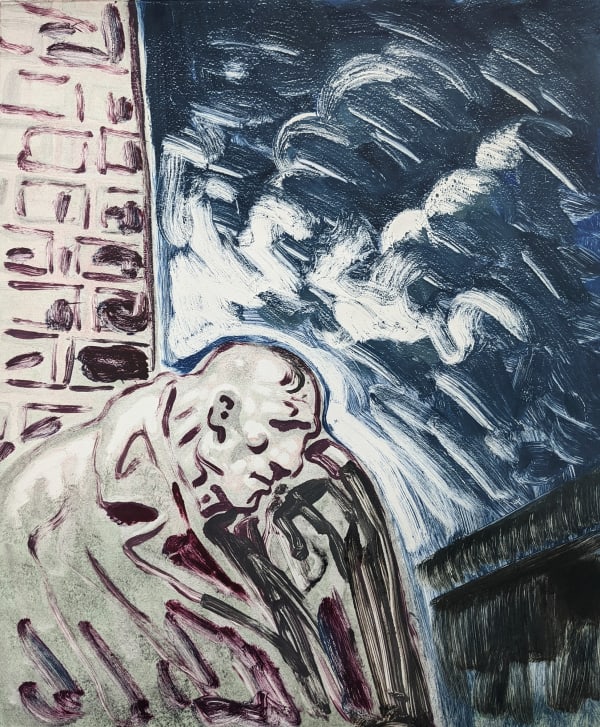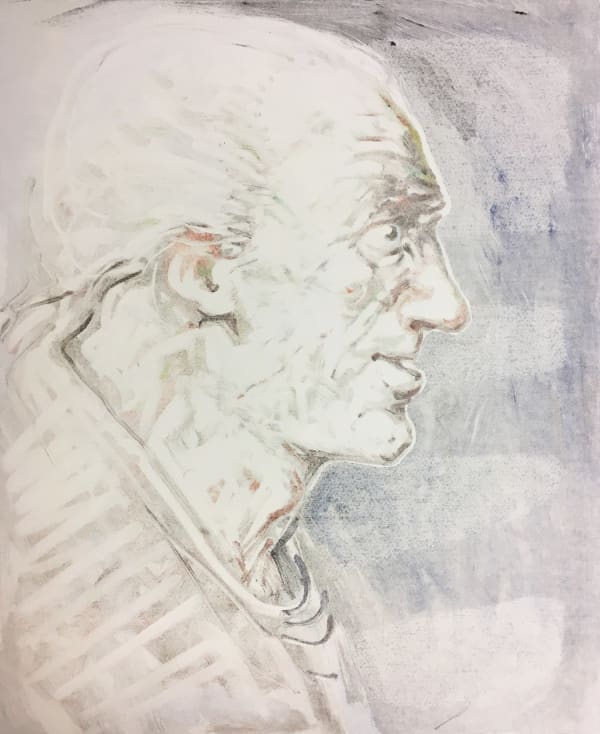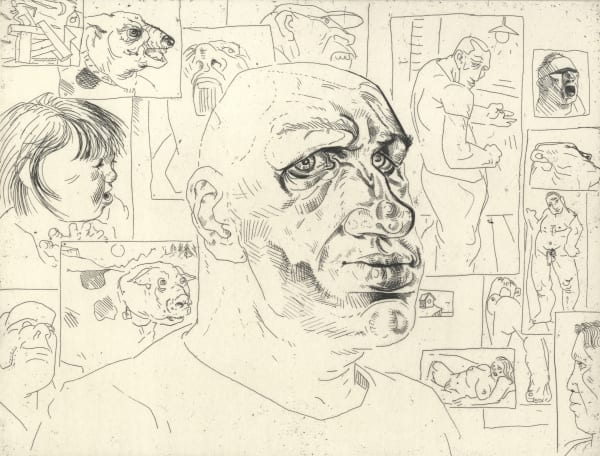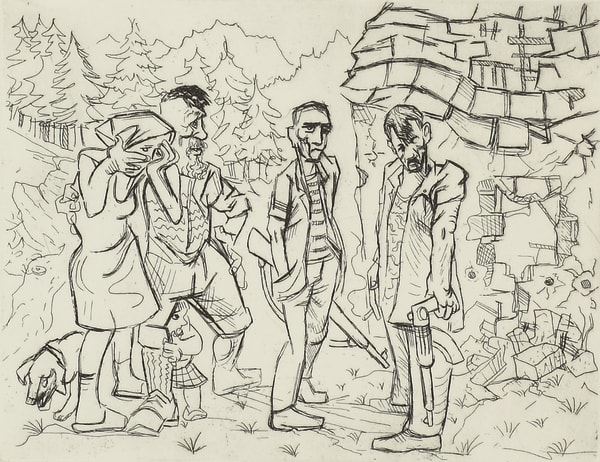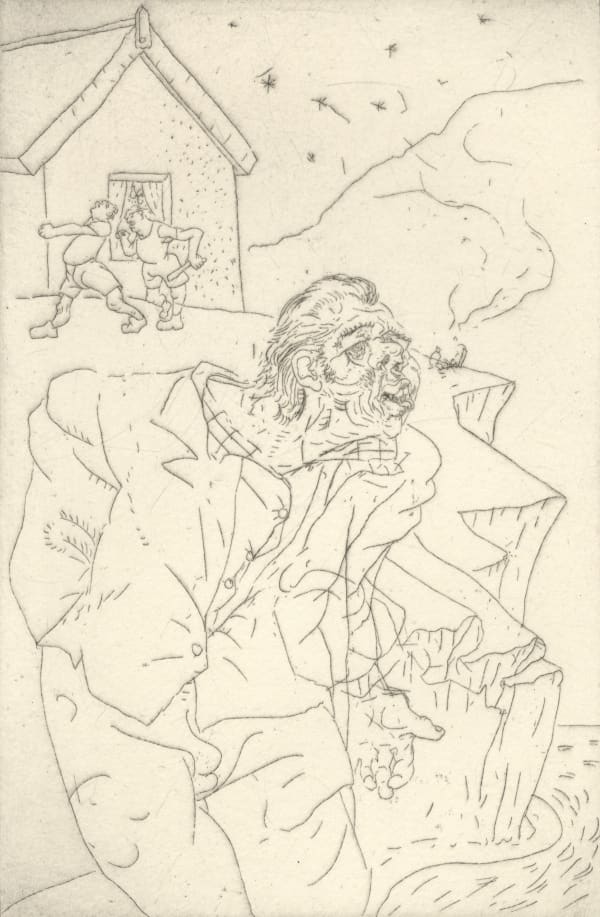Peter Howson: Ground Floor Gallery
Peter Howson at Glasgow Print Studio
Peter Howson (b.1958) is one of the most significant names in contemporary Scottish art. Alongside fellow GSA graduates, Ken Currie, Adrian Wiszniewski and Steven Campbell, Howson was a part of the influential 'New Glasgow Boys', who are credited with re-popularising figurative art in Scotland. The themes of Howson's paintings and prints are dark and visceral, and deal with the complexity of emotion in the human condition. Howson's art has carried with it a deep sense of anxiety of social degradation, through subject matter that has adapted to the changing social climate of the past four decades.
Howson is likely best known for his distinctive figurative paintings; large male figures overrun his compositions, with oversized extremities, coated in sinuous muscles. Although sometimes perceived as lauding this hyper-masculine image, Howson is in fact deeply critical through these representations. The figures can be seen as externalising a sense of conflict within the artist - of discomfort and envy borne out of childhood bullying. The displays of violence and toxic masculinity in his work being simultaneously a critique of others, and reflective of the feelings as they exist within himself.
Howson's subject matter shifted decisively when he was selected as the official war artist for the Bosnia conflict in 1993. Funded by the Imperial War Museum and Times Newspaper, Howson travelled to the country as it experienced a violent war that divided the countries diverse ethnic groups, and resulted in the genocide of thousands of Muslim Bosniaks. The initial trip, early in 1993, ended prematurely as Howson contracted dysentery. Feeling he was being portrayed as a coward in the public eye, Howson returned to Bosnia in 1994, which is when he created the bulk of his work. At one point his drawing materials were stolen, but with the feverish drive to keep creating, he continued to work in boot polish and candlewax.
The prints he made during this time reflect the complex horror of war. Works such as 'Muslim Woman', which portrays a woman he met in an isolated Muslim village, are intimate portraits that humanise the people facing these atrocities. 'Near Redoubt' portrays simplified figures, whose expressions are at once vacant, apprehensive, terrified and indignant; they could be seen to represent those caught in the fighting, and the universal anguish of war. The exhibition of Howson's Bosnia works in 1994 was highly controversial.* Scenes of decapitations, mutilated corpses, and graphic portrayals of sexual violence took prominence in the show. Whilst war artists such as John Singer Sargant and Paul Nash in the First World War, or Anthony Gross in the Second World War, portrayed the destruction caused by the theatre of war, and the scale of human impact, the horror was not always so explicitly presented.
Howson has used religious iconography throughout his career; his monotype, 'Death of Innocence' includes a repeated motif by the artist - clambering masses stringing up a figure bound to a crucifix. The association of Christ with light and innocence, juxtaposed with the unthinking clamorous mob. Howson converted to Christianity in the year 2000, whilst in an addiction treatment facility. Since then, religious imagery has come to the forefront in his art. He has frequently portrayed Christ, in similar anguish to his figures from the Bosnia works. He created a series of works based on the Stations of the Cross, in both print and painting. He has frequently depicted Saint Andrew, patron saint of Scotland, and Saint John Ogilvie, a Scottish Catholic who was executed in 1615; one of these painting now hangs in St Andrew's Cathedral. He has not censored his style for the sake of this subject matter, rather highlighting the violence and tragedy of Christian history.
A full selection of publications from Glasgow Print Studio by Peter Howson can be found here.
-
 Peter Howson, Man with Cigarette, 1982
Peter Howson, Man with Cigarette, 1982 -
 Peter Howson, Sky, 2001£ 3,600.00
Peter Howson, Sky, 2001£ 3,600.00 -
 Peter Howson, Death of Innocence, 1990£ 6,000.00
Peter Howson, Death of Innocence, 1990£ 6,000.00 -
 Peter Howson, Destroyer, 2001£ 4,800.00
Peter Howson, Destroyer, 2001£ 4,800.00 -
 Peter Howson, Magnus, 2001£ 3,600.00
Peter Howson, Magnus, 2001£ 3,600.00 -
 Peter Howson, Genesis I, 2001£ 4,800.00
Peter Howson, Genesis I, 2001£ 4,800.00 -
 Peter Howson, Pale, 2001£ 3,600.00
Peter Howson, Pale, 2001£ 3,600.00 -
 Peter Howson, Studio, 1992£ 900.00
Peter Howson, Studio, 1992£ 900.00 -
 Peter Howson, Sonny, 1990£ 780.00
Peter Howson, Sonny, 1990£ 780.00 -
 Peter Howson, Near Redoubt, 1994£ 600.00
Peter Howson, Near Redoubt, 1994£ 600.00 -
 Peter Howson, Jive Mother, 1990£ 780.00
Peter Howson, Jive Mother, 1990£ 780.00 -
 Peter Howson, Cleansed, 1994£ 780.00
Peter Howson, Cleansed, 1994£ 780.00


